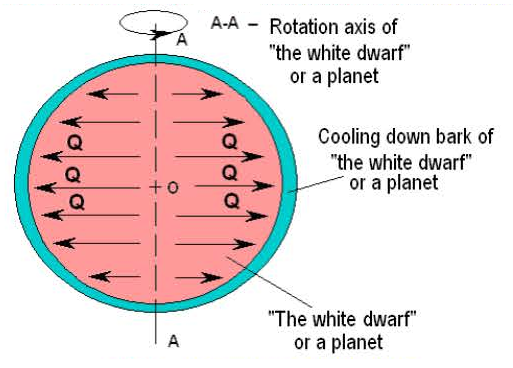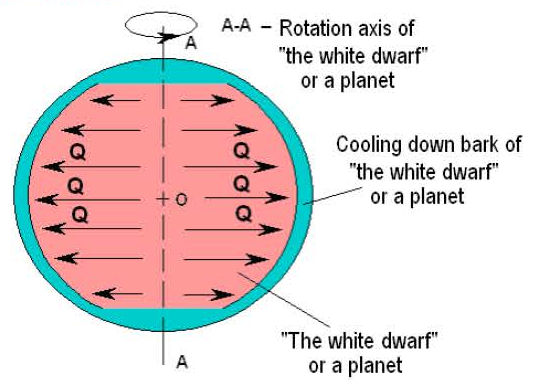In many cases, this movement of gases and dust brings to a beginning of synthesis around the «white dwarf». This process being perceived by astronomers and astrophysicists as gravitational attraction of the «white dwarf», and that’s creates a mistake while calculating its mass, it seems to be bigger.
If the fact we have stated will be proved right, the fundament of modern astrophysics, built on gravitational attraction of huge mass, «white dwarf», «neutron star» and «black hole» – will turn out to be a mistake. In there is no doubt about that.
What happen to the stars after they «die»?
It’s impossible to give a simple and uniquely answer to this question. Each star has its own physical parameters and surrounded by all kindsof external conditions.
The stars are categorized in three groups. We’ll divide them conventionally to stars with small mass, that doesn’t collapse. Stars with average mass that after the collapse turn into «neutron stars». And star of a large mass – after they collapse, a «black hole» remains.
«White dwarf» is the kernel of former star, consists from the products of drossing that were collected during the whole life period of the star, presented by hot melted ball that spin around its axis.
It’s still unknown if there is a hard kernel inside of the «white dwarf».
The existence of the atmosphere depends on the mass.
As a result in process of synthesis, there was a lot of radioactive substance inside of the star, that’s makes the «white dwarf» a source of radioactive and warmth radiation.
The «white dwarf», stars of small mass, reduces its activity with time, since instable isotopes become stable and cool off. The cooling of the «white dwarf» starts in the outer layers.
There comes a moment when on the surface of the «white dwarf» a thick peel. In its early stages, because of the rotation of the «white dwarf» and the movement of the layers, at times it gets swallowed by the molten substance, and at times appears as separated islands.
From which elements consists this peel it’s hard to say. Light connections should surf up earlier, but the heavy ones, under the influence of the centrifugal forces supposed to surf up as well. During that period, an allocation of gases into the atmosphere takes place. With time the «white dwarf» gets all covered up by the peel and moves into a planet state. Awanderingplanetcanbecapturedbyastar.
With time the peel of the planet grows in thickness, since its molten part is cooling. During the process of cooling allocations of melted substance on the surface of the peel occurs, and as a result it’s landscape changing.
Is the «white dwarf» rotation in the planet state effects the cooling of the peel and planet? As seen on the example of earth the rotation of the planet causes effect and changing the parameters of the peel. Let’s study this effect closely by illustration №R-9.6.
During the rotation of a planet, melted hot partition of the substance that lies beyond the peel it rotating along with the planet. This partition of the substance is affected by a centrifugal force directed radially to the axis of rotation. As we see on illustration№R-9.6, the main pressure is on the peel which placed on the parallel to the axis of rotation, especially the equatorial areas, because specifically there the force of the centrifugal is brought up to the maximum. This fact explains the conciseness of earth on the pole sides.
The warmth pressure on the peel from the inside is being distributed similarly to the power force (physical). The main warmth pressure on the peel of the planet is caused on the platitude on the parallel to the axis of rotation, especially in the equator zone. In the direction of the poles there’s no warmth or physical influence.
If there’s no warmth pressure on the piles, the areas of the peel in the poles areas aren’t getting warmed from the inside.
(156) Illustration №R-9.7
The Sun warmth is not enough to warm these areas. Therefore, the low temperature in the poles and creation of areas that constantly being frozen can be explained not only by lack of warmth from the Sun, but also by the absence of warmth pressure in these areas from the inner side of the planet.
Because of the absence of warmth pressure on the poles, in these areas the cooling of the planet supposed to happen faster, hence, the peel of the planet on the side of the poles should be thicker than the equators (illustration №R-9.7). But in the areas of high pressure the probabilities of earthquakes, tearing and eruption of the planet peel are increasing. There are also volcanoes that throwing molten substance of the bowels to the outside. This substance cools down, increasing the thickness of the peel. If we’d analyze the seismic activity of the Earth we’ll see that the most calm in seismic sense areas are those who adjacent to the poles.
The effect of celestial bodies on the seismic activity hasn’t been studied yet. But it’s obviously that the motion of celestial bodies with large mass around the Earth should affect on the motion of molten mass substance under the peel, similar to the affect of the Moon on the water mass of the Earth, and the existence, as a result of that, of tides. Hence, similar tides supposed to take place under the planet peel.
If this phenomenon exists, the peel of the planet supposed to feel periodic loads that connected with the motion of neighboring stars, and from the motion the planet itself around the star. Hence, the motion of celestial bodies should affect the seismic activity of the planet. The most critical loads supposed to be felt on the planet when the celestial bodies stands up in a line, like during the «planets parade» and in moment of during solar shading.




